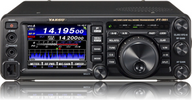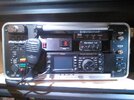User Review of the Yaesu All Mode FT-991(A) (original review of 3 Feb 2016 & update)
I needed a reasonably reliable base radio for 2.0 and 0.7 meters, something that could get me mobile UHF/VHF/HF in the event I ever needed it, and something that hopefully could utilize my preferred dynamic or condenser mics at my home station. I’ve had the radio for about 6 months now and, while being no expert at radio reviews by a long shot, I do like it a lot. The FT-991 just seemed to do it all for me, and the fact that it was Fusion AMS ready meant it could talk in DN (C4FM digital) mode with my other radios as well as other digital radios on one of my favorite Fusion repeaters in Concord (NH). The basic specs and link to the Yaesu website are given further below.
The Good:
Built like a tank, much like the 1200/5000, with a cast monolith frame and fairly sophisticated active cooling system. Much like the other Yaesu radios when paired up with the appropriate software, in this case the ADMS-991, programming is a breeze. It’s fast and it always works perfectly. I like ADMS because their customer support is 24/7 and always very good. And for the price of the Yaesu cable alone (which does not come with the radio) you get the entire ADMS suite: cable, disk, and support. Unlike the FTM-400 or 1000 it only displays a single channel, with both frequency and the text “name” of the station – but given the other features and band capacity I think it's well worth the trade-off. The build in speaker is well powered and sounds surprisingly good. The included MH-31 mic is standard grade but works fine, and the system works cleanly with dynamic mics such as the MD 100 or 200. The mic input on the front panel is the 8-pin RJ style which personally I could take or leave. I’ve never broken one but I hear they do break occasionally – the good part being that they are inexpensive to replace if you’re handy with wiring. I use the MD200 through a multi-radio switch box with the mic equalizer settings and that makes customization with a lot of different options very easy.
The layout feels good to me, tuning knob is just the right size, and the knob for switching channels in memory mode seems well placed. It appears to shares a lot of circuitry with the DX-1200 and operation, maneuvering through the menus, and filtering is very similar. I’m not a big color touch-screen fan – but it is cool when looking for certain features quickly. The antenna tuner is adequate, but if you’re on a long wire or experimenting with homebrews you’ll need something more robust. Like most of their HF rigs the tuner will only correct SWR 3:1 or better, and the tune memory will not save anything in one of the 100 memory slots that is outside of that range. The tuner will not even initiate if the SWR >3:1.
Most of the basic features, like band selection and Rx/Tx options, can be accessed through the touch screen in a fairly intuitive arrangement. Some reviews have complained about “menu depth” but once you get it down it is really effortless. The scope is cool, and is adjustable for bandwidth, but the only time I use it is when I’m looking for digital traffic on nearly frequencies.
I haven’t done a lot of HF work with it yet – but it seems to perform identical to the DX-1200 during digital nets along the east coast using fldigi. The 2.0 & 0.7 meter bands have gotten a workout on both verticals and Yagis and I am pleased with the performance. I really like the ability to fully dial VHF/UHF power from 0-50W – the mobile and HTs usually have 3 or 4 pre-set settings. The receiver seems to be a little more sensitive than the FTM-400 or 1000 to me which is a double edged sword, especially when you have several repeaters on the same frequency 180 degrees apart off a Yagi. Dublin seems to be the bullseye for such scenarios. Also not a real AM guy, but I’m guessing this is what you’d normally expect with AM at 25W – I’ve heard higher power radios actually sound a lot worse.
Connection to Wires-X is also easy, although you do need to purchase a unique cable (what a huge surprise for Yaesu). I’ve used it both as a node and a remote connected radio and encountered no issues with either set up. The GPS feature works well just like the rest of the product line – some people love it and some say it’s too slow on acquisition. Understand that it’s not a Garmin, but it does work. I like having it on a base radio so I can easily read how far away the other digital radio is from where I’m located.
Back panel layout is good, with a sturdy ground connection, and dual data/tuner connections for Wires-X and an external tuner at the same time. The CAT controller isn’t as intuitive as the 1200, but still a lot easier for changing set-up then working through the menu. But again, the on-screen menu system is pretty good.
The Bad:
The thing weighs a ton – a four liter radio without tubes or huge transformers shouldn’t weigh 10 pounds. It could conceivably bend your dashboard or home radio shelf. But if it’s as rugged as I think it may be, I’ll learn to live with it. As probably any 100W radio would, it needs a decent power supply : +13.8Vdc @ 25A. The Yaesu FP-1023A works but may not have the de-rating necessary to achieve full Tx power on inrush. I've heard complaints about the Tx never reaching full power but my suspicion (and Yaesu's) is that people may be scrimping on the power supply capacity.
Sometimes I have no idea what Yaesu is thinking with their pricing and sales philosophy. When the FT-991 was first released it had a MSRP of $1699. Even for an all-mode that seemed completely ridiculous to me. Today you can get it for $999 with the currently available rebate offers through HRO or most other outlets. (although the 991 A version have gone up in price a bit)
When in Wires-X, it does not have FR mode as an option so it cannot transmit or receive images through Wires-X system, plus there is not an input for the camera mic or user replaceable SD card for storing images or text files. This is a missed opportunity because the camera mic is a novelty that could appeal to users familiar with taking pictures with cell phone cameras. My guess is that future versions will correct this deficiency.
The only other thing I would have liked is rotor control, location memory, and position indication like on the 1200/5000, especially with VHF/UHF. Seems like I’m always ‘goosing’ the rotor on VHF to get it a little clearer, but given everything else – I’ll live with it.
The Ugly:
Nothing outrageous or glaringly out of place that I have found – front and back panels are about as good as it gets. The wire stand is a little hokey (supporting a $1000 radio with a coat hanger would not have been my choice) – but it comes with a nice set of four high feet to keep it an inch or so off the table top. The reviews I’ve seen online are well worth reading. Seriously - some of them are downright hysterical. My favorite being on eHam: “Things were fine until I experienced a direct lightning hit on my 40m tower – the piece of junk has been wacky ever since”.
Anyway, the radio probably has more features than I’ll ever dream of using – but the ones I do use, for voice, digital, Wires-X, and GPS tracking, seem to be good performers. As of this writing current FT-991 firmware is: Main (V02-10), C4FM DSP (V04-10), DSP (V01-05) and TFT (V02-01) 02/03/16.
73
Jim, WQ2H
Above photos by Yaesu
http://www.yaesu.com/indexVS.cfm?cm...8BE5568D7E2B5E2131&DivisionID=65&isArchived=0
FT-991 All-Mode Radio Features:
- 160 Meters through 70 Centimeters - SSB/CW/FM/C4FM Digital/AM
- 100 Watts (2 Meter / 70 Centimeter: 50 Watts) output power
- Frequency Ranges: RX 30 kHz - 56 MHz, 118 MHz - 164 MHz, 420 MHz - 470 MHz (amateur bands only)
- TX 1.8 MHz - 54 MHz, 144 MHz - 148 MHz, 430 MHz - 450 MHz (amateur bands only)
- 3.5 Inch TFT Full-Color Touch Panel Operation
- High Speed Spectrum Scope with ASC (Automatic Spectrum-Scope Control) built-in
- AMS, and Group Monitor fully utilize the potential of C4FM Digital (no FR mode)
- Triple Conversion Circuit (SSB/CW/AM)
- Double Conversion (FM/C4FM) Configuration, 1st IF is set at 69.450 MHz
- Roofing Filters 3 kHz and 15 kHz as standard equipment
- IF WIDTH and IF SHIFT provides great QRM Rejection
- CONTOUR, DNR, IF Notch and APF (Audio Peak Filter, CW only)
- 160 - 6 Meters High Speed Automatic Antenna Tuner included
- High Accuracy TCXO ±0.5 ppm
- Built-in Electronic Keyer
- CW Message Memory with Beacon Mode
- CW Pitch/Sidetone Control
- Automatic Repeater Shift
- USB Connector (CAT control, Audio interface, PTT/SHIFT control)
- Two Antenna Connectors (HF/50MHz, 144/430MHz)
- Case Size(W x H x D): 9.0" x 3.2" x 9.3" (w/o knob and connector)
Update 18 Nov 2023:
There were not really a lot of big changes from 991 to 991A, so I have not included those changes here.
Current (and EOL) FT-991 firmware is: Main (V03-01), C4FM DSP (V04-15), DSP (V01-11) and TFT (V03-00).
This transceiver has subsequentially been put into my go-box for remote operation (where it seems reasonable happy). Photo by "me".
Attachments
Last edited:


